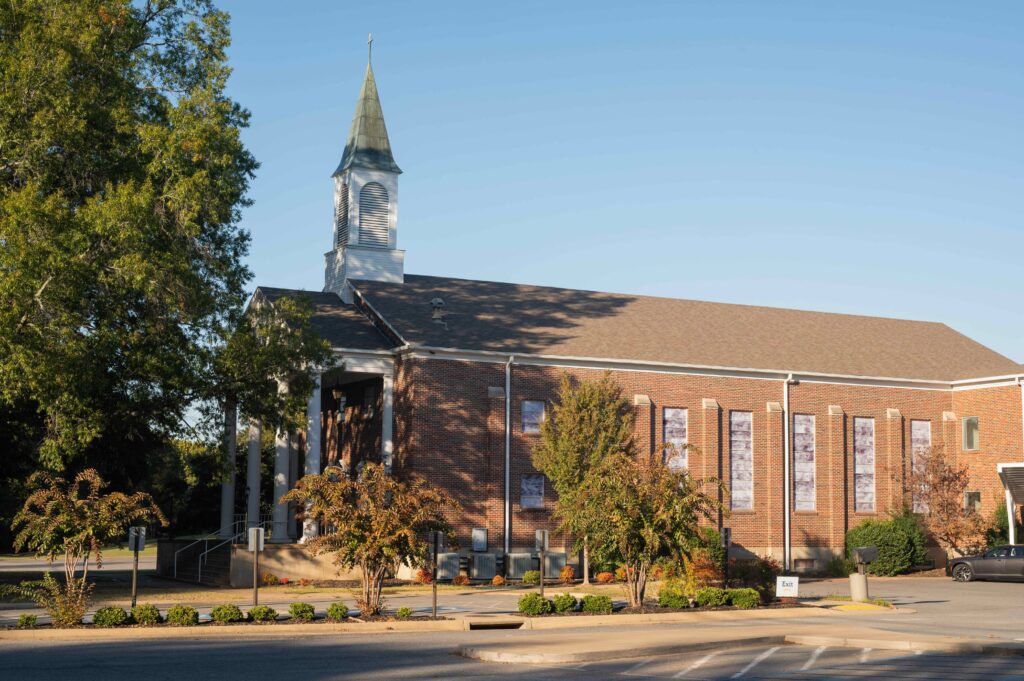
Amanda Toye and Cerra-Cathryn Anderson/ Photo by Abigail Callicoat
The Christian community in Searcy, Arkansas, is thriving and growing on old roots of foundational community churches. Harding University serves as a center for the Church of Christ community in Searcy, but much history and community exists outside of our campus boundaries.
Smyrna Methodist Church sits on the west side of town, boasting the title of the oldest documented church in Arkansas. Smyrna was founded as a church in the mid-19th century. Shelly Churchwell, the president of the White County Historical Society, shared some of the history of the local churches.
“Churches had church on Sundays, during daylight hours as there was no electricity, often served as community gathering places, and Smyrna was built at a busy crossroads from trees that were onsite,” Churchwell said. “When someone in the community died, the bell would ring the number of their age so the community would have a guess who it was.”
Churchwell remarked that tight communities were vital to the surrounding area.
“Strong communities make a strong county,” Churchwell said.
Searcy First Methodist Church, also built in the mid-19th century, still stands downtown as a fixture of the timeless quality of the Christian community.
Though the oldest churches in Searcy are not Church of Christ fellowships, the Church of Christ community is now a strong presence in the town.
Shawn Daggett, a Harding Bible assistant professor and elder at Cloverdale Church of Christ, shared his perspective on this congregation which began as a small group. Daggett attended Cloverdale as a senior undergraduate student at the University, and it was there that he felt called to pursue missions. The Cloverdale community supported him and his wife’s missionary work for 10 years.
Daggett encourages students to commit to and invest in a Searcy church during their time at the University.
“I have observed that as students serve in churches while in college, so shall they be after college,” Daggett said. “Beyond offering hospitality, warmth, and mentoring through small groups and ‘adopt a college student’ programs, the Searcy churches set a good and healthy high bar for what churches ought to be.”
Jordan Guy, also an assistant professor of Harding’s College of Bible and Ministry, shared his perspective on living, working and worshiping in the Searcy community as a Harding employee.
“There’s nothing quite like living in Searcy and working at Harding,” Guy said. “It’s two worlds in motion that feed off each other in the pursuit of progress and growth but with consistency and faithfulness.
Courtney Dawson, the local outreach pastor at Fellowship Bible Church, shared her faith in the power of community through the churches of Searcy. She is encouraged when Harding students choose to invest in their community.
“I know a lot of students who come to [Harding University] wanting to make a difference in the community and are not just here for themselves,” Dawson said. “People see that and are drawn to that kind of love and compassion.”
The Downtown and College Churches of Christ are well known to Harding students. They began meeting as a congregation in the early 20th century, and their impact on the Harding and Searcy communities is evident through their service and outreach.
Kyle Thompson, the assistant director of Harding’s Office of Community Connections, spoke to the unifying practices that break down barriers. The Office of Community Connections works with churches and the University to connect the Searcy community to resources.
“I visit a lot of campuses too and realize that until you know your way around a place, it’s always daunting,” Thompson said.
Thompson volunteers at events such as a community-wide yard sale at his home church, Downtown Church of Christ. He appreciates that his job allows him to break down unspoken barriers between what people often perceive as two separate entities in town: the Harding community and the Searcy community.
Dr. Monte Cox, the dean of the College of Bible and Ministry at Harding and a member of the Downtown Church of Christ, shared his perspective on the shift of Church of Christ churches from “sameness” to flourishing in their diversity. He believes this is closer to the original goals of the Church of Christ movement.
“As we have grown beyond the sectarianism that characterized the Churches of Christ when I was young, we’ve actually come closer to the ideals of our movement from 200 years ago, which was intended to be a non-sectarian, unified force among Christ-followers,” Cox said. “We’re more like that now than we used to be, I think, so that’s good.”
Cox shared his appreciation for unifying practices like the “40 Days of Prayer” guide that many churches in Searcy are actively working through. The “40 Days of Prayer” movement was published by the Searcy Ministerial Alliance and was spearheaded by Kent Jobe, the preaching minister at Downtown Church of Christ. Each prayer was written by a different minister from various congregations and denominations in the Searcy community and serves as a unifying practice across congregations.
Jobe spoke about the growing community between the churches of Searcy.
“The ministerial alliance is very strong in Searcy with a lot of different congregations represented and a deep desire to focus on the foundational truths that unite us,” Jobe said.
Cox and Jobe believe that movements like the “40 Days of Prayer” unify the church without asking anyone to sacrifice the unique aspects of their specific church body.
“I think it is more true than it’s ever been that we can hold onto distinctives that make our fellowship unique here unique, or that fellowship unique, and still agree that there’s a core gospel that we, by and large, agree on, and we don’t need to be fighting against each other,” Cox said. “We need to be pulling for each other.”